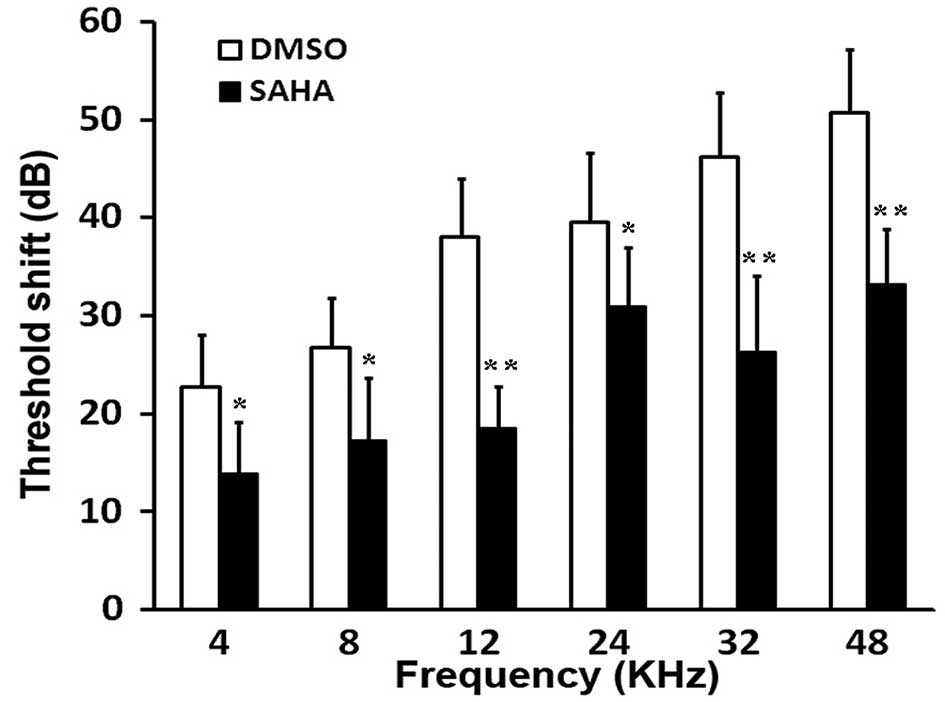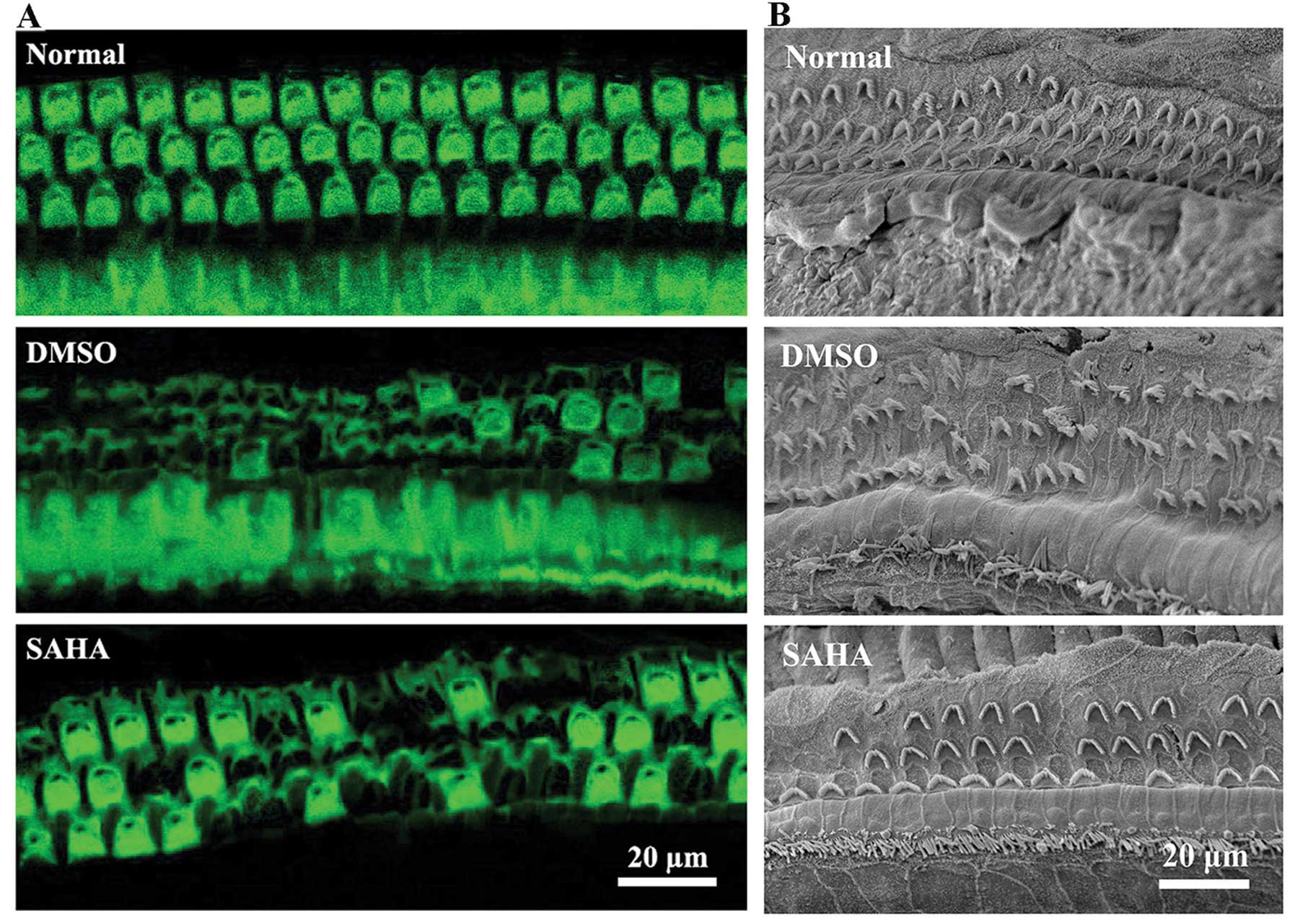|
1
|
Sliwinska-Kowalska M and Davis A:
Noise-induced hearing loss. Noise Health. 14:274–280. 2012.
View Article : Google Scholar : PubMed/NCBI
|
|
2
|
Goodyear RJ, Jones SM, Sharifi L, Forge A
and Richardson GP: Hair bundle defects and loss of function in the
vestibular end organs of mice lacking the receptor-like inositol
lipid phosphatase PTPRQ. J Neurosci. 32:2762–2772. 2012. View Article : Google Scholar : PubMed/NCBI
|
|
3
|
Chen FQ, Schacht J and Sha SH:
Aminoglycoside-induced histone deacetylation and hair cell death in
the mouse cochlea. J Neurochem. 108:1226–1236. 2009. View Article : Google Scholar : PubMed/NCBI
|
|
4
|
Shakespear MR, Halili MA, Irvine KM,
Fairlie DP and Sweet MJ: Histone deacetylases as regulators of
inflammation and immunity. Trends Immunol. 32:335–343. 2011.
View Article : Google Scholar : PubMed/NCBI
|
|
5
|
Gao L, Cueto MA, Asselbergs F and Atadja
P: Cloning and functional characterization of HDAC11, a novel
member of the human histone deacetylase family. J Biol Chem.
277:25748–25755. 2002. View Article : Google Scholar : PubMed/NCBI
|
|
6
|
Morrison BE, Majdzadeh N, Zhang X, Lyles
A, Bassel-Duby R, Olson EN and D’Mello SR: Neuroprotection by
histone deacetylase-related protein. Mol Cell Biol. 26:3550–3564.
2006. View Article : Google Scholar : PubMed/NCBI
|
|
7
|
De Ruijter A, Van Gennip A, Caron H, Kemp
S and van Kuilenburg A: Histone deacetylases (HDACs):
characterization of the classical HDAC family. Biochem J.
370:737–749. 2003. View Article : Google Scholar
|
|
8
|
Sadri-Vakili G and Cha JH: Mechanisms of
disease: histone modifications in Huntington’s disease. Nat Clin
Pract Neuro. 2:330–338. 2006. View Article : Google Scholar
|
|
9
|
Strasák L, Bártová E, Harnicarová A,
Galiová G, Krejcí J and Kozubek S: H3K9 acetylation and radial
chromatin positioning. J Cell Physiol. 220:91–101. 2009. View Article : Google Scholar : PubMed/NCBI
|
|
10
|
Jiang H, Sha SH and Schacht J: Kanamycin
alters cytoplasmic and nuclear phosphoinositide signaling in the
organ of Corti in vivo. J Neurochem. 99:269–276. 2006. View Article : Google Scholar : PubMed/NCBI
|
|
11
|
Hiebert SW and Stengel KR: Class I HDACs
affect DNA replication, repair and chromatin structure:
implications for cancer therapy. Antioxid Redox Signal. Jun
26–2014.Epub ahead of print.
|
|
12
|
Feng W, Zhang B, Cai D and Zou X:
Therapeutic potential of histone deacetylase inhibitors in
pancreatic cancer. Cancer Lett. 347:183–190. 2014. View Article : Google Scholar : PubMed/NCBI
|
|
13
|
Rikiishi H: Autophagic and apoptotic
effects of HDAC inhibitors on cancer cells. J Biomed Biotechnol.
2011:Article ID 830260. 2011. View Article : Google Scholar : PubMed/NCBI
|
|
14
|
Rabinowitz PM: Noise-induced hearing loss.
Am Fam Physician. 61:2759–2760. 2000.
|
|
15
|
Nair C: Noise-induced hearing loss.
InnovAiT. 7:204–208. 2014.
|
|
16
|
Kingston RE and Narlikar GJ: ATP-dependent
remodeling and acetylation as regulators of chromatin fluidity.
Genes Dev. 13:2339–2352. 1999. View Article : Google Scholar : PubMed/NCBI
|
|
17
|
Stilling RM and Fischer A: The role of
histone acetylation in age-associated memory impairment and
Alzheimer’s disease. Neurobiol Learn Mem. 96:19–26. 2011.
View Article : Google Scholar : PubMed/NCBI
|
|
18
|
Song C, Kanthasamy A, Anantharam V, Sun F
and Kanthasamy AG: Environmental neurotoxic pesticide increases
histone acetylation to promote apoptosis in dopaminergic neuronal
cells: relevance to epigenetic mechanisms of neurodegeneration. Mol
Pharmacol. 77:621–632. 2010. View Article : Google Scholar : PubMed/NCBI
|
|
19
|
Gräff J and Tsai LH: Histone acetylation:
molecular mnemonics on the chromatin. Nat Rev Neurosci. 14:97–111.
2013. View
Article : Google Scholar : PubMed/NCBI
|
|
20
|
Bassett SA and Barnett MP: The role of
dietary histone deacetylases (HDACs) inhibitors in health and
disease. Nutrients. 6:4273–4301. 2014. View Article : Google Scholar : PubMed/NCBI
|
|
21
|
Zwergel C, Valente S, Jacob C and Mai A:
Emerging approaches for histone deacetylase inhibitor drug
discovery. Expert Opin Drug Discov. 10:599–613. 2015. View Article : Google Scholar : PubMed/NCBI
|
|
22
|
Konsoula Z and Barile FA: Epigenetic
histone acetylation and deacetylation mechanisms in experimental
models of neurodegenerative disorders. J Pharmacol Toxicol Methods.
66:215–220. 2012. View Article : Google Scholar : PubMed/NCBI
|
|
23
|
Vieyra D, Loewith R, Scott M, Bonnefin P,
Boisvert FM, Cheema P, Pastyryeva S, Meijer M, Johnston RN and
Bazett-Jones DP: Human ING1 proteins differentially regulate
histone acetylation. J Biol Chem. 277:29832–29839. 2002. View Article : Google Scholar : PubMed/NCBI
|
|
24
|
Marks PA, Miller T and Richon VM: Histone
deacetylases. Curr Opin Pharmacol. 3:344–351. 2003. View Article : Google Scholar : PubMed/NCBI
|
|
25
|
Chuang DM, Leng Y, Marinova Z, Kim HJ and
Chiu CT: Multiple roles of HDAC inhibition in neurodegenerative
conditions. Trends Neurosci. 32:591–601. 2009. View Article : Google Scholar : PubMed/NCBI
|
|
26
|
Halili MA, Andrews MR, Sweet MJ and
Fairlie DP: Histone deacetylase inhibitors in inflammatory disease.
Curr Top Med Chem. 9:309–319. 2009. View Article : Google Scholar : PubMed/NCBI
|
|
27
|
Huang L: Targeting histone deacetylases
for the treatment of cancer and inflammatory diseases. J Cell
Physiol. 209:611–616. 2006. View Article : Google Scholar : PubMed/NCBI
|
|
28
|
Dietz KC and Casaccia P: HDAC inhibitors
and neurodegeneration: at the edge between protection and damage.
Pharmacol Res. 62:11–17. 2010. View Article : Google Scholar : PubMed/NCBI
|
|
29
|
Jia H, Pallos J, Jacques V, Lau A, Tang B,
Cooper A, Syed A, Purcell J, Chen Y, Sharma S, et al: Histone
deacetylase (HDAC) inhibitors targeting HDAC3 and HDAC1 ameliorate
polyglutamine-elicited phenotypes in model systems of Huntington’s
disease. Neurobiol Dis. 46:351–361. 2012. View Article : Google Scholar : PubMed/NCBI
|
|
30
|
Soragni E, Xu C, Cooper A, Plasterer HL,
Rusche JR and Gottesfeld JM: Evaluation of histone deacetylase
inhibitors as therapeutics for neurodegenerative diseases. Methods
Mol Biol. 793:495–508. 2011. View Article : Google Scholar : PubMed/NCBI
|
|
31
|
Roger T, Lugrin J, Le Roy D, Goy G,
Mombelli M, Koessler T, Ding XC, Chanson AL, Reymond MK and
Miconnet I: Histone deacetylase inhibitors impair innate immune
responses to Toll-like receptor agonists and to infection. Blood.
117:1205–1217. 2011. View Article : Google Scholar
|
|
32
|
Kim HJ and Bae SC: Histone deacetylase
inhibitors: molecular mechanisms of action and clinical trials as
anti-cancer drugs. Am J Transl Res. 3:166–179. 2011.PubMed/NCBI
|
|
33
|
Piekarz R and Bates S: A review of
depsipeptide and other histone deacetylase inhibitors in clinical
trials. Curr Pharm Des. 10:2289–2298. 2004. View Article : Google Scholar : PubMed/NCBI
|
|
34
|
Prince HM, Bishton MJ and Harrison SJ:
Clinical studies of histone deacetylase inhibitors. Clin Cancer
Res. 15:3958–3969. 2009. View Article : Google Scholar : PubMed/NCBI
|













